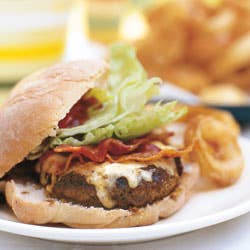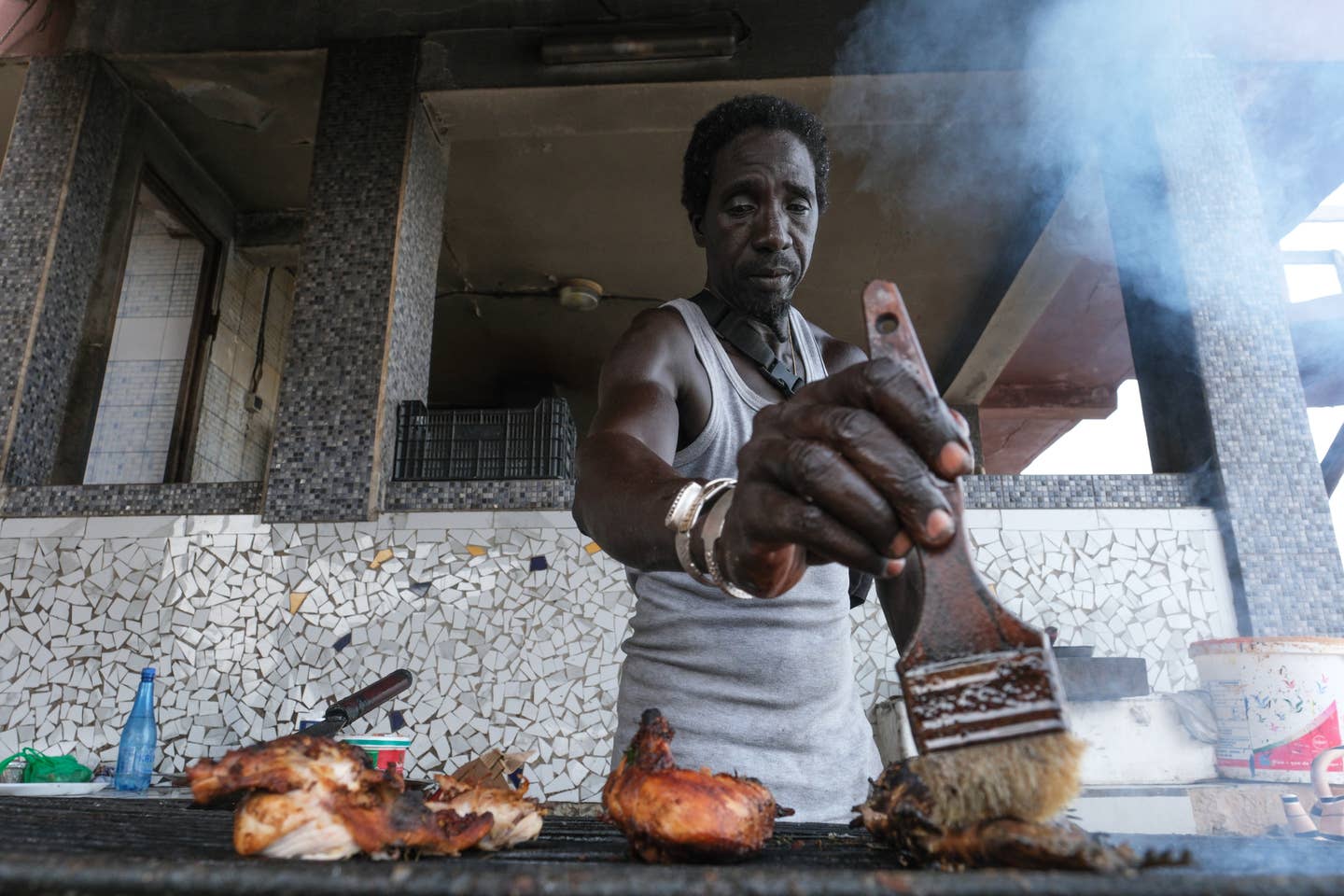
Hamburger Rules
Is there any other dish so immediately and vividly satisfying and delicious as this all-American specialty? Nope.
Is there any other dish so immediately and vividly satisfying and delicious as this all-American specialty? Nope.
I take a bite, and a world of flavors and textures reveals itself: the animal saltiness of well-seasoned, moist ground beef, its abundant juices soaking into the soft, sweet white flesh of the flour-dusted roll; the sourness of the vaguely chewy melted sharp cheddar; the crisp, saline, smoky authority of well-cooked bacon; the faint crunch of a cool iceberg lettuce leaf turned translucent by the warmth of the meat and cheese.
I am bewitched, seduced, transported. I am satisfied even before I have begun to digest. At times like this, I am quite prepared to propose the perfectly constructed bacon cheeseburger as proof of the existence of God.
I love hamburgers. When it comes to this variously enhanced, definitively American (but unquestionably universal) sandwich I am a true believer. I would rather eat a burger than a hot dog, a pizza, or a chunk of chocolate cake. I would rather eat a burger than a T-bone. If I were told that I had to give up either hamburgers or foie gras for the rest of my life, I'd swear off that fattened poultry liver so fast you wouldn't see my lips move. And if I were then told that I had to give up hamburgers anyway, I do believe I'd get old Doc Kevor-kian on the line. They will pry this burger from my cold, dead fingers.
A culinary psychotherapist (and if there isn't such a beast, I'm sure one will pop up soon, probably on the Food Network-Frasier meets Emeril) would no doubt find evidence of arrested development, of nostalgie de baby-food, in my predilection for ground-up protein-which extends far beyond the hamburger and its cousin meat loaf, incidentally, to encompass sausages of every description, pates and rillettes, chicken croquettes, even fish cakes.... Let them think what they want.
I mean, I've got perfectly good teeth and enjoy applying them to sirloin steaks and lamb chops and baby back ribs as much as the next carnivore. But there is something about meat or fowl or fish that has been ground or finely chopped or shredded, then properly seasoned and correctly cooked, that appeals to me immediately and viscerally, that gladdens my heart, that connects me with neither artifice nor irony to the sheer pleasure of eating.
A Hamburger is literally a person or thing from the city of Hamburg, the great northern German port that was part of the Hanseatic League in medieval times. What this Teutonic municipality has to do with Big Macs and Whoppers is a subject of much speculation, some of it quite silly. The Hamburg New Media Association even devotes several pages of its website to the question. Like many other would-be authorities on the subject, the New Media folks trace the burger's beginnings back to the Tartar hordes who swept out of Central Asia about 750 years ago, supposedly riding across the steppes with slabs of raw animal flesh lodged between their saddles and their mounts. The meat was thus tenderized, it is said, and when the Tartars stopped for the night, they'd simply chop the meat up and dig in. (Think steak tartare.) How and why some saddle-softened Central Asian warriors' fodder became a "Russian delicacy" (as those New Media Hamburgers call it) in Hamburg and eventually found its way to America with a Hamburg provenance attached is not revealed.
"Hamburger steak" first appeared on an American menu as early as 1834, at Delmonico's in New York City-but the precise nature of the dish is unclear. The recipe for "beef steak, Hamburg style" offered by Charles Ranhofer, former chef of Delmonico's, in his book The Epicurean (1893) is a melange of chopped beef tenderloin and suet and chopped onions fried in butter, seasoned with salt, pepper, and nutmeg, shaped into four-ounce balls, flattened, rolled in bread crumbs, fried in butter, and served with "a good thickened gravy"-not exactly the burger as we know it today. Neither was Fannie Farmer's version. The recipe, generally credited as the first ever published, for "hamburg steaks" in her Boston Cooking-School Cook Book (1891) called for chopped lean beef, salt and pepper, and onion juice or chopped shallots, with a slightly beaten egg and "a few gratings of nutmeg" as optional additions.
Slightly earlier, circa 1888, James Henry Salisbury, a British physician, proposed simply seasoned ground beef, eaten three times a day, as a specific against anemia, colitis, tuberculosis, and other ailments. (Much later, Salisbury steak came to mean a fancified ground beef patty, often oval in shape, served without a bun but usually with a brown sauce or at least a sprinkling of parsley in upscale American or "Continental" restaurants.)
The good people of Seymour, Wisconsin, about 20 miles west of Green Bay, meanwhile, believe fervently that the hamburger was invented in 1885 by local son Charlie Nagreen, who is said to have improvised it at the Outagamie County Fair by flattening a meatball and sticking it between two slices of bread for his customers to eat while walking around the fairgrounds. Other claimants to the burger's paternity include Frank Menches of Akron, Ohio (1892); Louis Lassen of Louis' Lunch in New Haven, Connecticut (1900); and Fletch "Old Dave" Davis of Athens, Texas, who took his burger to the 1904 Louisiana Purchase Exhibition in St. Louis, where it gained wide exposure.
No one can say for sure when or where the classic modern-style burger on a bun first appeared, with its traditional garnish of tomato slice, lettuce leaf, and sometimes onion, sometimes cheese. Its rise in popularity did seem to mirror that of the automobile, though, for it was the perfect "fast food"-quick to cook and easy to eat. You could even hold it to your mouth with one hand while keeping the other hand on the steering wheel. It is hardly accidental that many early burger joints were drive-ins.
The first nationwide burger chain was White Castle, which was founded in 1921 in Wichita, Kansas. Wimpy's (inspired by a burger-loving character in the "Popeye" cartoons), Bob's Big Boy, Steak n Shake, and A&W, among others, followed. Then one day in 1954, Ray Kroc, a Chicago-based milk-shake-
machine salesman, visited a pre-ternaturally bustling fast-food joint run by brothers Maurice and Richard McDonald in San Bernardino, California. The next thing anybody knew, he owned the name and the concept, and McDonald's had sold something like 90 gazillion burgers all over the world and changed forever our culture, our eating habits, and for that matter our burger.
I can't pretend to remember my first hamburger, but I almost certainly encountered it as a youngster at a drugstore lunch counter in Southern California, where it was almost certainly served on a sesame bun, in an oval wicker basket lined with waxed paper, nestled against a heap of french fries. I suspect that I was hooked immediately. Like so many children, though, I was a picky eater and wanted nothing but cheese on my patty-no lettuce or tomatoes, no pickles or onions, no mustard or ketchup or relish. I gradually came to appreciate lettuce, tomatoes, and onions (especially fried or grilled), but to this day I avoid pickles (their mocking pungent sweetness overpowers everything else), and I am alone among my friends and coworkers, I think, in eschewing all condiments. The purity of the undressed burger, with its elemental, guileless counterpoint of flavors and textures, is to me a thing of beauty.
Of course, just as everybody has a favorite burger joint-loyalty to such regional chains as Corpus Christi's Whataburger or Southern California's In-N-Out Burger, not to mention such local treasures as Hut's in Austin, Corner Bistro in Manhattan, Zip's in Cincinnati, Dick's Drive-In in Seattle, and suchlike, can be as passionate as football fandom-it's also true that just about everybody orders, or makes, burgers his or her own way.
The hamburger is very nearly a blank canvas-a lunch-tabula rasa. About the only absolute essential is a patty of cooked ground beef ("burgers" made of ground turkey or salmon or stuff like that are nothing but sorry imitations, imperfect metaphors, like "margaritas" made with wine or "pizza" topped with ersatz cheese), and even the patty admits some variation: things may be added to the meat-egg, bread crumbs, cheese, butter, parsley, onion, Tabasco, worcestershire sauce, whatever; it may be seasoned with just salt and pepper or with soy sauce, lemon or lime juice, paprika, red pepper, and/or a number of other things; it may be small and thin in shape or broad and plump or anything in between; it may be fried, grilled, broiled, even boiled.
Then there's the question of the bun: slightly spongy, golden-brown-top classic (the prototype of which was supposedly invented in 1916), with or without sesame seeds? potato roll? kaiser roll? Portuguese roll? sourdough toast? rye toast (as in the great Southern California coffee-shop classic the patty melt)? english muffin (don't laugh; there are people who swear by it)? And the literally scores of possible garnishes-not just the traditional ones, but anything from bacon to arugula, sauerkraut to chili (as in another SoCal specialty, the open-face chili size)-and the countless jarred or bottled sauces or relishes. And the cheese, whether american, cheddar, swiss, jack, chevre, blue, or... Combine these variables in every possible way, and you've got probably thousands of potential personalized burgers, thousands of interpretations of this most emblematic of American culinary creations.
And emblematic the burger is-a triple-decker cultural affirmation for each of us who enjoys one, an edible symbol that announces three things: I eat meat. I am an American, perhaps in nationality but certainly in spirit. And I know what I like, which is simply this: my hamburger.
Keep Reading
Continue to Next Story










